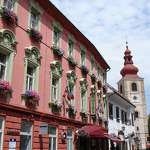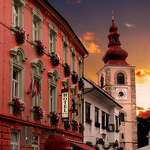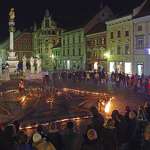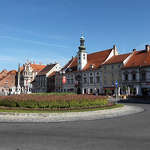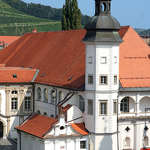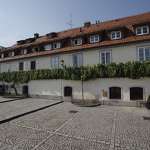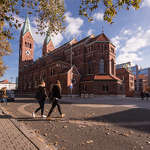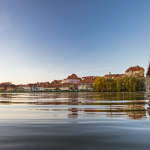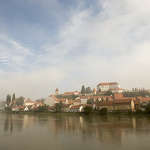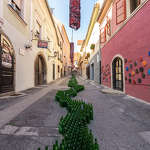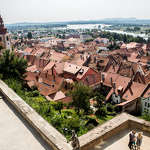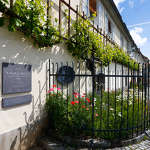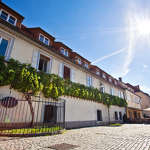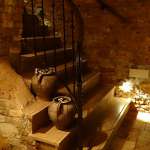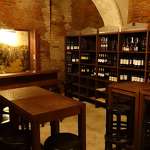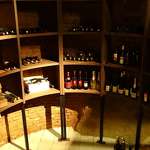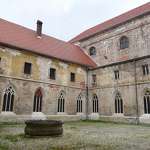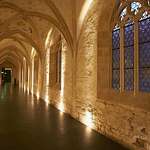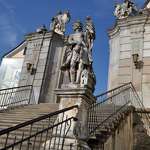
From the Minorites to the Franciscans
North-eastern Slovenia is a synonym for a region rich in viniculture and brimming with history. The numerous monasteries that are still active are part of the cultural heritage. The oldest Slovenian town, Ptuj, which is liveliest during the carnival was famous already in Roman times and has managed to preserve its charm to this very day. The second largest city in Slovenia, Maribor, is credited as being the wine capital of the country as it is home to the oldest vine in the world. The city organises the world-famous Lent festival that attracts numerous outstanding artists each year.
OVERVIEW
DAY 1:
Ptuj is an old town overlooked by a once mighty castle. Its best known attraction is the carnival character Kurent that was recognised by UNESCO and which drives away winter each spring during one of the most colourful carnivals in the world. After a stroll through town, you will stop at a Minorite monastery and see the Church of Saint Peter and Saint Paul, one of the oldest gothic churches in Slovenia that was beautifully renovated during the baroque period. Lunch is organised in one of the local restaurants famed for excellent food. To make your experience of Ptuj a memorable one, you will visit the Dominican Monastery that was able to develop into an artistic treasure trove thanks to the donations from rich noblemen and the bourgeoisie. Today, it is seen as one of the great European monuments. It was built over several construction phases in mediaeval times, and was given baroque features at the turn of the 18th century. The feature that you will admire the most is the cross-shaped hallway designed in the early 13th century. As Slovenia is a land of wine and Ptuj being its mighty representative with a plethora of wine cellars, you will be treated to a visit to one of the cellars. The tasting of Štajerska wines in the vaulted cellar is certain to be a special experience. To finish off the day, you will dine at the hotel.
DAY 2:
After breakfast, you will take a drive to the nearby Ptujska Gora village that boasts a cornucopia of gothic statues from the beginning of the 15th century. The Basilica of the Patroness Mary is believed to be the most beautiful Slovenian gothic monuments and one of the most popular pilgrimage temples. You will admire exceptional statues and church furnishings in the mighty three-nave space built at the turn of the 15th century. At its centre is the high altar with the Misericordia of the Patroness Mary. The relief was created around 1410 and features 82 people. It is a unique group portrait of individuals who lived 600 years ago. The nearby city of Maribor is the second largest city in Slovenia that has numerous sites and attractions to offer the visitor. One of them is certainly the Franciscan Monastery with the Basilica of the St. Mary Mother of Mercy, which is one of the biggest churches in Slovenia; it is 57.5 m long and features the high altar with the merciful image created from 17 types of marble. After lunch showcasing the local delicacies, you will see the rest of the sites of Maribor that include the Lent town quarter and the main attraction of Maribor: the oldest wine in the world.
PACKAGE PRICE PER PERSON
- VIP package with a guide and transportation: from 278 €
- Group trip: from 219 €
THE ADVENTURE/PACKAGE INCLUDES
- Sightseeing in Ptuj
- Visit to the Minorite monastery
- Visit to the Dominican monastery
- Visit to the Ptujska Gora
- Visit to the Franciscan monastery
- Sightseeing in Maribor
- 1 x wine tasting
- 2 x lunch in the selected restaurant
- 1 x dinner
- 1 x overnight stay with breakfast at the hotel ****
For more information about trips and activities click here.
ADDITIONAL INFORMATION
- Program can be carried out from 1 May to 31 October, arrivals possible every day of the week
- the program is intended for groups of 2–7 persons and larger groups for which the program can be adapted
- Possible to combine two or more packages
- Tourist fee is included in the price
- Due to the Covid-19 situation, VIP tours and group tours are suspended until further notice.
Grand Hotel Primus ****
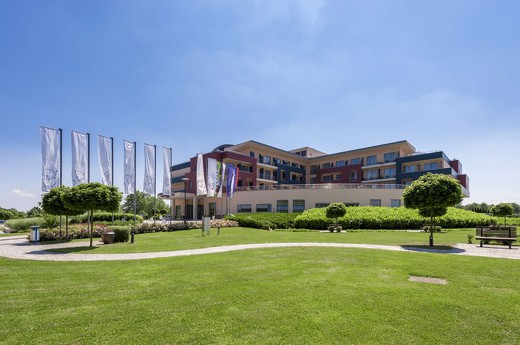
Through a prism of modern times, Grand Hotel Primus reveals how the wealthy Romans who passed this region enjoyed life. You can enjoy yourself, too, either in the hotel pool and in the wellness centre, or you can join the party on central pools, which are especially lively in summer with their slides. The hotel is located in the centre of the spa facility. You can relax at the Valens Augusta wellness, with its thermal baths, and the World of saunas Flavia, you can also treat yourself to various beauty programmes or massages. Feel free to dive into the intimate atmosphere of the pool complex Vespasianus, that includes a children’s pool, pool with an outdoor exit and two whirlpools. There is a Thermal park nearby for double the fun.
The hotel, named after the famour Roman warrior Marcus Antonius Primus, has a total of 118 rooms with modern design. All rooms have an LCD TV, free WiFi, a minibar, and most of them also have a balcony.
The hotel restaurant offers self-service breakfasts.
Hotel Mitra ***

You will find Hotel Mitra in the pleasant environment of the old city centre of Ptuj.
The hotel is part of the Story Hotels chain of standard small hotels, each of which is run as a family company. In addition to the top of the line accommodation services and classic hotel services, each hotels offer an interesting story and highlights traditional values and characteristics of the place where it operates. They also provide an authentic and pleasant atmosphere as well as the warm and cosy feel of home.
You can also create your own story here. Will it be a story of relaxation or exciting experiences? The Venera Wellness Salon offering saunas, whirlpools and massages is here for your relaxation. The wine cellar invites you to learn about wine culture and taste their excellent wines. If you are looking for a gift to give your friends, we can assure you that you will not go wrong with a top-tier bottle of wine that you can buy at this wine cellar.
While you stay here, you should make sure to visit Ptuj, the oldest Slovenian town. Visit one of the most prestigious castles in Slovenia and enjoy the vistas across the tiled roofs and cobbled streets. The Slovenski and Mestni trg squares are also something to behold. If you are at Ptuj during the Kurent Carnival, you are sure to spot a mystical being or two and the most important character of Ptuj, the Kurent, in the street, while you can find this carnival character at the Kurent Room or the mask collection at the Ptuj Castle at other times of the year.
Just as in the city centre, you will also feel the intertwinement of history and modernity in your hotel room. The hotel offers 29 themed rooms. The rooms are equipped with a satellite TV, free WiFi, mini bar and hairdryer.
Start your day with a breakfast at the dining room and the Kipertz house coffee in the Mitrov vrt garden that is a true haven removed from the hustle and bustle of the city streets. Later, you can treat yourself to a dessert and a refreshing drink at the garden.
Maribor

Maribor and its old town centre will amaze you with their cultural-historical attractions and the hospitality of the locals. The beautiful town square with famous edifices, Lent with the oldest vine in the world, the City Park with three fishponds and the Pyramid… Coffee and tea shops will lure you to the charming small streets and alleys where you will be able to chat with friends and relive your experiences after the sightseeing.
Ptuj
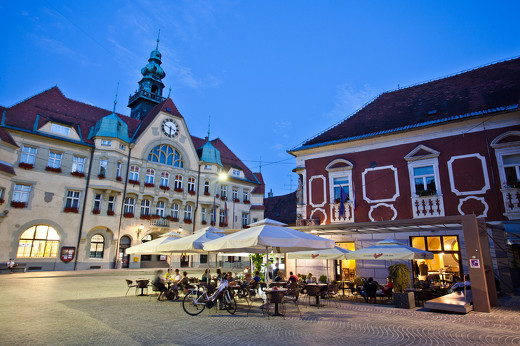
Ptuj is an extremely interesting and mysterious city with the oldest history in Slovenia, numerous attractions and a genuine tourist offer. The city lies in a picturesque landscape between the Slovenske Gorice and Haloze, and the Drava and Ptuj Fields where many natural beauty spots are intertwined. Ptuj is not only the oldest Slovenian city. It is a city of festivals and many other cultural events enriching the old city centre and the neighbouring towns throughout the year.
These places are a real paradise for even the most demanding gourmets and lovers of authentic home cooking. Tourist farms and wine shops in Ptuj are famous for their excellent home-made food and excellent wines. In short, by visiting the oldest city in Slovenia and its picturesque countryside with the gentle hills of the Slovenske Gorice and Haloze you will discover a small part of the world well worth visiting or spending your leisure time.
Vinska klet Osterberger

The Osterberger Wine Cellar and wine bar is named after the first hotel owners, Franz and Constanza Osterberger, who bought a house when it was auctioned in 1890. They also obtained the right to open a coffee house. The family stayed in the hotel until 1945 when it became a state-owned property.
The facade holds the initials of the owners, namely the initials of their names F(ranz) C(onstanza) O(sterberger). Franc Osterberger died in 1905 and his business was taken over by the widow, Constanza. After her death the property was inherited by their children. Their son Franc Osterberger later run the hotel, and Alexander was the manager of the Osterberger estate in Gorca, Dežno 43. The building with baroque facade and a very interesting history is now a beautiful city hotel Mitra. It is in the surroundings of the historic town of Ptuj, at Prešeren Street 6 and Grajska Street 1. The hotel with its location, exterior and interior arrangements reflects the appearance of the old city centre. The first record of the object is from 1777.
The hotel reminds us of yet another story with the renovated wine cellar and wine shop. The story was an important part in the development of the rich heritage of the present-day hotel and the oldest Slovene town of Ptuj. Some years before and after 1900, the hotel performed an extremely important activity of the time. It was Franc Osterberger, the elder son who was not only the owner of a hotel and cafeteria, but also a wine producer and wine wholesaler specialized in wines from the Haloze area.
In 1907, the Association of Agricultural Societies of Styria awarded a silver medal to Osterberger wine production with an honorary certificate for his achievements in the field of viticulture.
The wine cellar can accommodates up to 40 lovers of vintage wine, and due to its rich offer of wine each visitor can choose and buy premium wine for oneself or friends. Tantalizing aroma, sophisticated flavour, delightful fragrance, wine culture and careful production of winegrowers from the wine-growing regions of Slovenia will create a story of history for each visitor to the renovated wine cellar Osterberger. The guests can pamper their taste buds in top quality wines such as Traminec, Renski Riesling, Yellow Muscat, Blue Pinot, Šipon, Cviček, Rebula, Merlot, etc. A visit to the Osterberger wine cellar and the tasting of top quality wine is definitely an unforgettable adventure and, above all, a necessary part when walking and exploring the oldest Slovenian town of Ptuj.
World’s Oldest Vine

In the heart of the old city centre on Lent, the oldest vine in the world still grows in front of the Old Vine House. The confirmed age of this “Žametovka” or “Modra Kavčina” vine is over 400 years, which won it a place in the Guinness Book of Records as the oldest noble vine in the world still bearing grapes. The Old Vine is a symbol of the rich wine culture of Maribor, Styria, and all of Slovenia.
The Old Vine was planted towards the end of the Middle Ages when Maribor was besieged by the Turks. It survived the furious fights between the invaders and the defenders of the city, as the Old Vine House used to be a part of the city wall. Then, the vine was not harmed by the fires which occurred frequently due to wooden roof structures and straw coverings, nor by the vine lice that destroyed most of other vines. Despite the Allied bombing of the city during World War II that partly destroyed the Old Vine House, this resilient plant survived unscathed.
Today, the Old Vine is the only plant with its own museum in the Old Vine House. The scions of the Old Vine grow on almost all continents and in several places in Slovenia. The Maribor Octet and the Neuvirtovi Štajerci band even recoded an anthem in its honour. Several picturesque wine cellars and wine roads in Maribor and surroundings are also dedicated to the Old Vine.
The Old Vine bears grapes of the “žametovka” or the “modra kavčina” sort which was one of the first domesticated noble vine sorts in Slovenia. The yearly harvest of around 35 to 55 kg of grapes is made into wine and poured into 2.5 dl bottles designed by a famous artist Oskar Kogoj. These bottles are a valuable protocol gift – only hundred bottles are filled every year!
Dominican Monastery
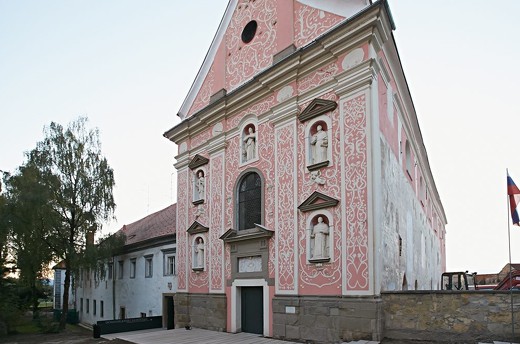
The huge building complex of the Dominican monastery in Ptuj with more than 2,000 m2 on the ground floor and just as much on the first floor and in the basement with the congress and cultural centre has a diverse past. Throughout history, Ptuj has been organized around three buildings: Ptuj Castle, the Minorite and Dominican monasteries. Therefore, the Minorite monastery has been one of the most important buildings in Ptuj throughout history. A 13-century rectangular monastery had its own walls in the Middle Ages that were connected to the system of the city fortification. Part of this wall is still preserved. It can be seen in the south where there is an escarp (a fortified wall to defend the building) towards the Drava River, while the remains of a tower can be found in the western part. There used to be a trench and smaller entrance to the city. In front of the monastery, there is a park called the Sunny Park. Its terrace above the Drava River offers a beautiful view of the southern part of the city, the Drava Field and all the way to Haloze, Donačka Gora and Boča and Pohorje. The Salzburg Archbishop Eberhard II (1200-1246) and Matilda Ptujska (died 1253), a widow of Frederick III, are credited with the establishment of the Dominican monastery in Ptuj.
The monastery was built on two floors already in the earliest period, and the eastern tract of the cloister (oratory) is certainly its most beautiful part. In the first half of the 13th century until the construction of a church on its north side, it served as a chapel. The construction of the church was one of the most demanding works in the monastery associated with high expenditure and it lasted until 1252. The church was consecrated in 1255 on request of the Dominicans. It was consecrated by the Archbishop of Salzburg Philip Spanheim. The anniversary of consecration is celebrated on the third Sunday after Easter. The old chapel opens onto the corridor with a portal and a double lancet window (arched window is vertically divided into two identical parts with a column or tower, and with decorative ribs at the top). The portal is the result of several restorations. The monastery is built in a transitional style between Romanesque and Gothic, which is beautifully seen in the chapel in the eastern tract, where the right double lancet window is still late Romanesque (double window with semicircular arches), and the left one is already Gothic (with pointed conclusions and other details). Originally, the old chapel had a flat ceiling, and it was not vaulted until the 17th century. The traces of a belt with decorative paintings are preserved and they indicate the height of the original flat ceiling. On the eastern side, the chapel had a presbytery (a central, usually somewhat raised area in the church where the priest conducts religious services) that extended into today's park. Only the arch in the eastern wall still reminds us of the presbytery. Until recently, the old chapel was the exhibition area of the Ptuj Museum with its gothic statues and the remains of early gothic frescoes from the demolished Minorite church.
Ptujska Gora
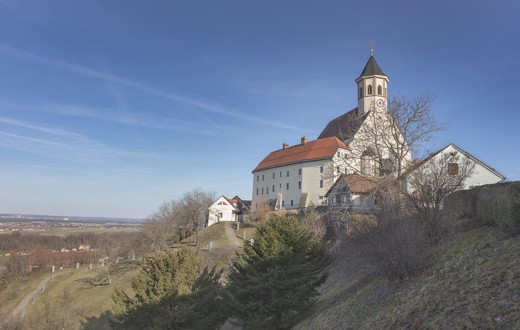
The Church of Virgin Mary the Protector at Ptujska Gora is considered to be the most beautiful art of the Middle Ages in Slovenia, the Song of Solomon of Slovenian Gothic. It combines the main art forms. Architecture, sculpture and painting were intertwined at an aesthetic and creative level of artistic movements from the most important European centres of art. A tour of the building and its contents does not only guarantee an extraordinary aesthetic experience and a walk into a special spiritual world that emerged at Ptujska Gora 600 years ago. Its reality is also a reflection and realization of various ideas from historical reality, human gratitude and deep faith in God's grace.
The most ancient known name for Ptujska Gora has been preserved in Latin, Mons gratiarum (Mountain of Grace), associated with the basis of the Slovenian name of Gora, while the German version of the name of Maria Neustift is already connected with the construction of the church dedicated to Mary. Although there are a number of legends about the Mary's sanctuary at Ptujska Gora, its beginnings are connected with the vow of the then most important representatives of the Styrian nobility who returned home after a heavy defeat of the Christian army against the Turks in Nikopol in Bulgaria in 1396. One of the main initiators of the construction of the church was Ulrich IV from the Walsee-Drossendorf family, the then court masters of Duke Wilhelm of Austria and from 1396 the tenant of the Majdburg farm, a former castle near Lovrenc in the Drava Field. After his death in 1400, Bernard Ptujski took over the responsibility for the construction. Count of Celje Herman II also contributed his share. He most probably financed a special altar of Mary's Annunciation in the middle of the church.
The construction of the church was completed around 1410 as a three-nave hall with an altar and a bell tower included in the body of the nave, following the example of two important pilgrimage churches in Styria, in Straßengle and Pöllauberg. The financers then called the best masters in Central Europe at the time who shaped their artistic language on the construction sites of St. Vida in Prague and St. Stephen in Vienna and in the lands of the German Knight Order.
As a pilgrimage destination, the building was exposed to various disasters and joys through centuries. In the 17th and 18th centuries, it was managed by the Jesuits, and in 1786 the church became the seat of a new parish. From 1937 onwards it has been managed by the Minorites. In 2010, the church celebrated an important jubilee, 600 years of its construction. At the same time 2010 also represents an important turning point in the history of the church at Ptujska Gora. Pope Benedict XVI signed the document with which the church was elevated to a basilica. The church is now called the Basilica of Virgin Mary the Protector at Ptujska Gora.
Franciscan monastery
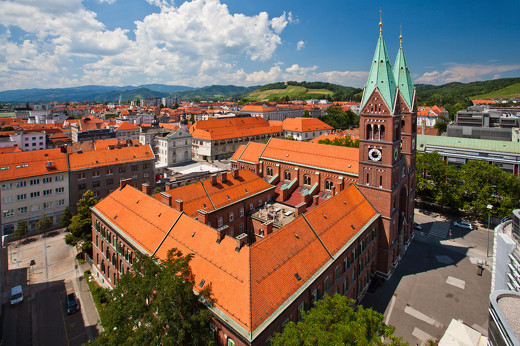
The Order of Friars Minor probably came to Maribor in 1240. In 1282, they constructed a monastery at the succursal church of Our Lady of Assumption. The painting of the Mother of Mercy was provided to the church in 1747. In that year, they moved to the former Capuchin monastery, and in 1864, the Franciscans took over the church, the monastery and the parish. In 1900, they built a new monastery and a church which has been a basilica since 1906.
The Franciscan Church is a magnificent building with a facade made of red clinker at the crossroads of Partizanska and Svetozarevska streets. The most important building in Maribor from the period of historicism is a three-nave basilica dedicated to Mary, Mother of Mercy. The plans for the new church and the monastery were made by Richard Jordan. It was constructed between 1892 and 1900. Previously, this was the location of the Church of the Mother of Mercy and Capuchin monastery.
Majestic two-tower basilica of Our Mother of Mercy characterised by the neo-Romanesque style reflects the ambition of the city at the turn of the 20th century because with it the city aligned itself with larger cities such as Vienna and Graz. With its red-bricked facade and adjoining Franciscan monastery it emphasizes the access to the city centre on the east side. The majority of paintings inside the church were painted by the Hungarian artist Ferenz Pruszinskay, the Way of the Cross was carved by Miloš Hohnjec from Celje. In the presbytery there are frescoes and stained glass windows that are the work of the artist Stane Kregar. The organ was made by the Mariborian master Jožef Brandl. On the main altar is the pilgrimage statue of Mary dating from the 18th century.
Minorite Monastery
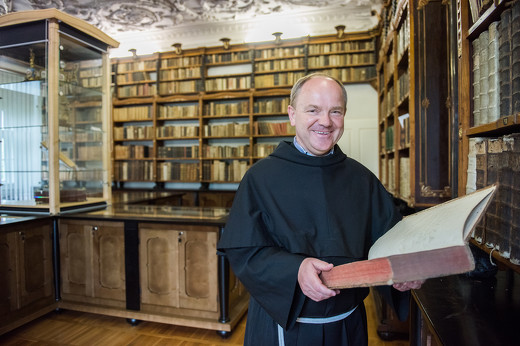
The Minorite monastery in Ptuj is one of the most important buildings of the historic centre which closes the old part of the city at Minorite Square towards the west. The lower part of the square closes a monolithic white monastery wall with a beautiful baroque church of St. Peter and Paul leaning on it. In its façade above the entrance, decorated with four tall pillars, the church patrons, St. Peter and Paul are placed in niches on the left and on the right side.
The oldest Slovene town, known for its historic centre has been even richer and more beautiful after the completion of the renovation of the Minorite Church of St. Peter and Paul, the renovation of which began in 2001. Even today, the monastery plays an important cultural and educational role. Since 2007, it has had a private monastery music school and it also hosts a very active Society of Intellectuals of Victorin Ptujski with a rich cultural programme. The refectory or the dining room and the yard host concerts, exhibitions and various meetings. The monastery library in the south-western corner on the 2nd floor is of exceptional national importance. Based on the book collection it can be concluded that the establishment of the library dates back to the beginning of the 16th century. It was transferred to the corner stucco in 1925.
The monastery boasts a library with over 5000 books, some of them dating as far back as the 16th century and the majority of them are from the 17th and 18th century. The most valuable work is Trubar's New Testament from 1557, 1560 and 1561. The last appendix of Paul's letter to the Corinthians and Galatians was the most complete specimen until a few years ago when the last part of 1577 was discovered in Jerusalem. But even now it is extraordinary due to its volume. It is very interesting that the Minorite library remained fairly well preserved during the last war. Only few valuable books are missing. The oldest date in the library is not associated with any of the books but with a parchment of the Theodosius Code from the 9th century serving as a book cover. More recently, the library has obtained two more valuable books, a facsimile of the Pericopes of Henry II - a book of Sunday readings, and a facsimile of Gutenberg's bible. In the Minorite monastery, there is also a provincial library that began its operations on 8 February 2008. It contains 14,000 books that can be borrowed. The library is open on Wednesdays between 9am and 11am and on Thursdays between 16am and 6pm. It is also possible to borrow books outside the opening hours based on a prior agreement. The library is included in Cobiss programme of Slovene libraries. It is interesting, in particular, that the library contains many books that cannot be found in other libraries.
- H1 Grand Hotel Primus ****
- H2 Hotel Mitra ***
- 3 Maribor
- 4 Ptuj
- 5 Vinska klet Osterberger
- 6 World’s Oldest Vine
- 7 Dominican Monastery
- 8 Ptujska Gora
- 9 Franciscan monastery
- 10 Minorite Monastery
-
- VIP tour with tourist guide and transportation
- Group trip
-
No. of peopleConfirm
Transfer from the airport
Guests arriving by air will be offered comfortable transfers at competitive prices from close by airports. Our chauffeur will meet you at the arrival and will bring you back safely and on time
to the airport at the departure. You can cancel the transfer from your home to the hotel without expenses within 72 hours prior to scheduled transfer. You will receive the information about the exact time of departure a day before the scheduled transfer.
-
From - to:
-
Distance:km
-
Travel time:h
-
Type of transfer:One-way transfer
-
Price:€ per person
-
Number of people:
-
From - to:
-
Distance:km
-
Travel time:h
-
Type of transfer:Return transfer
-
Price:€ per person
-
Number of people:
Transfer from home to the hotel
Guests from northern Italy are offered the possibility of transport from home to the hotel. You can choose between
morning or afternoon directory term, the carriage is available for 2-7 passengers, reservation up to 5 days prior to departure. The notice of the exact time and location of departure one day prior to the tour.
-
From - to:BENETKE - MORAVSKE TOPLICE
-
Distance:km
-
Travel time:h
-
Type of transfer:One-way transfer
-
Price:€ per person
-
Number of people:
-
From - to:BENETKE - MORAVSKE TOPLICE
-
Distance:550 km
-
Travel time:5,5h
-
Type of transfer:Return transfer
-
Price:€ per person
-
Number of people:
Holidays in Slovenia portal.
You will receive an automatic reservation recapitulation on your e-mail address,
final confirmation will be sent upon payment.
You will receive an update on your reservation within 2 hours; if not, please, call us as soon as possible or send e-mail. Also check SPAM.
Thank you for your confidence and best regards.
HolidaysinSlovenia.eu






